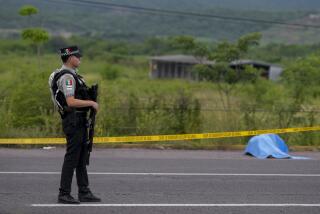Rising ‘Crack’ Epidemic : Colombia Now Stung by Curse of Cocaine
- Share via
BOGOTA, Colombia — When Jaime Rodriguez and his wife made a long-planned second honeymoon visit to the United States, they left their son, Jorge, in charge of their apartment and automobile.
The house, the car and the son were gone when they came home six weeks later.
“When we returned home, our key didn’t fit in the apartment door. At first we thought there was some mistake,” Rodriguez said.
It was no mistake. While his parents were away, Jorge, a 16-year-old honors student, sold the car and the apartment to finance his pernicious penchant for smoking basuco, the Colombian version of “crack,” or cocaine in rock form.
Son Found Dead
More than a month went by before Rodriguez found his son--dead of pulmonary dysfunction. He had literally smoked himself to death.
“We think he developed the addiction in the short time we were away,” the boy’s father said. “He never was that way before.”
Cocaine, once Colombia’s curse on the rest of the world, is finally hitting home.
Since 1980, use of basuco has reached epidemic proportions. Studies conducted by mental health authorities show that 86.3% of the population between ages 10 and 40 have tried basuco; up to 20% are addicts. A 1986 United Nations report listed the Colombian basuco epidemic as one of the worst drug problems in the world.
‘Poisoning Own Country’
“Suddenly, we realize that the Colombian cocaine Mafia is poisoning its own country as well as others,” Alberto Camacho, a toxicologist, said.
“Colombian officials actually used to think that cocaine was just a North American problem,” said Dr. Jairo Luna, head of the Mental Health Division of the Ministry of Health. “But cases like the Rodriguezes have made us wake up to the fact that we are all vulnerable to its ravages.”
Colombia did not have any serious drug problem until 1980. Cocaine baron Pablo Escobar, currently in hiding, was once quoted as saying: “Cocaine? That’s for the dumb gringos. We wouldn’t touch that crap.”
“We were the world’s main exporter of cocaine, but we didn’t see that this might cause a problem here at home,” Luna said.
Basuco Impurities Dangerous
The major problem today is basuco, which experts say is much worse than the crack that recently swept the United States. Crack is pure. But basuco is a brick-colored powder full of impurities, including lead, caustic soda, sulfuric acid, potassium permanganate and kerosene.
“Ingesting it,” said Ronald Siegel, a psychopharmacologist at the UCLA Medical School, “can lead to schizophrenia, lead poisoning or death. It’s a dirty crack, 10 times worse.”
Basuco was born out of the greed of Colombia’s drug barons. In the late 1970s, Escobar and others tried to eliminate Bolivia as a major supplier of coca paste, the raw material for processing cocaine hydrochloride crystal. They imported coca seeds from Bolivia and, using airplanes and helicopters, bombarded hills and valleys with the seeds in an attempt to grow their own.
Experiment ‘Backfired’
“The idea was to produce coca leaf here. But it backfired. The result was a leaf with low alkaloid content below export standards,” Police Gen. Gustavo Gonzalez said.
The cocaine Mafia, though, was not about to lose money on its investment. Unable to export it, the drug lords began to peddle the impure basuco for pennies inside Colombia. Today, police estimate that about 75,000 acres are planted with coca. About 75 tons are produced annually--about half of what the U.S. Drug Enforcement Administration says is consumed in the United States.
Most of the plantations are small, as little as five acres, farmed by poor families in jungle areas.
“It is practically impossible for the police to get rid of it,” a DEA agent in Colombia said.
Environmental Concerns
So far, because of environmental concerns, the Colombian government has not approved the use of herbicides to eradicate the coca plant, as has been done with marijuana. So the only way to kill the plant is to uproot and burn it.
“But the coca plant springs right back and provides an even better harvest nine months after the police pruning,” narcotics Police Col. Augusto Garcia said.
Garcia is currently involved in a campaign to cut down 25,000 acres of plants spread over 3,000 farms in the country’s jungly Putumayo Territory, adjacent to Ecuador. But he calculates that by the time his men finish cutting down the plants, half of the farms will be back in production.
The small farmers no longer grow food crops, such as corn or cassava root. They have subsisted on coca now for about six years and believe so strongly in their right to do so that they recently organized a demonstration in the town of Mocoa, capital of Putumayo, to protest police action against “our only cash crop.”
Basuco Price Plummeting
Overproduction, however, is causing the price of basuco to plummet.
“A year ago, these farmers would sell 25-pound bushels for $8, and now the price is $4,” a DEA agent said.
As a result of the basuco epidemic, the hottest new businesses in Colombia are drug rehabilitation clinics.
“In 1976, there were four such centers in Bogota. Today, there are 42,” said Evaristo Arevalo, therapist at the Clinica Uribe Cualla.
Smoking Dens Increase
At the same time, basuco smoking dens have popped up all over Bogota.
“In high-class neighborhoods, you see the Mercedes-Benz parked outside places with red-leather furniture and marble tables,” Garcia said. “In poor areas, smokers squat over foul-smelling wood floors.”
There are even hints the epidemic is starting to claim drug lords themselves.
Some observers speculate that cocaine king Carlos Lehder was captured in February because he had his guard down. He was using drugs himself.
More to Read
Sign up for Essential California
The most important California stories and recommendations in your inbox every morning.
You may occasionally receive promotional content from the Los Angeles Times.










